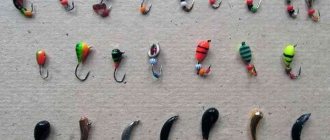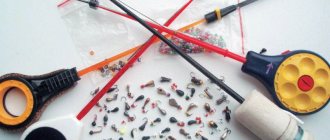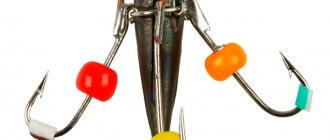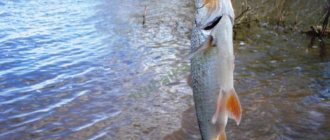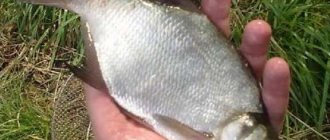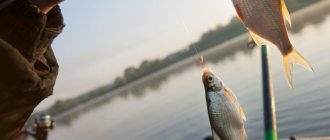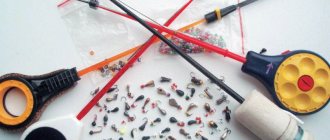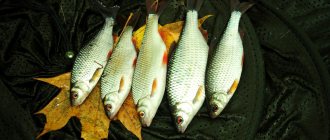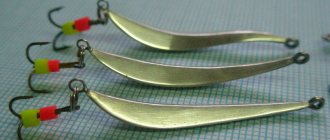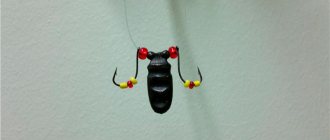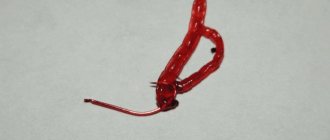Roach jigs for winter fishing should have the following basic characteristics:
Among the fishing fraternity, there is an ongoing debate about which jig is best for catching roach from the ice. Some claim that this is a small fish, others successfully catch it with drop-shaped products, while others are quite happy with a tablet (Tula washer). In fact, there is no magic bait, and the result largely depends on how correctly the fishing place is chosen, how the tackle is assembled and what technique or techniques of the game the angler owns.
A jig is a universal bait that is most often used for catching roach. Helps with fishing both in winter and in open water in other seasons. The efficiency of fishing depends on how correctly the jigs for roach are selected for winter fishing.
When choosing a winter jig for roach, you should pay attention to the following criteria:
- season;
- depth of the reservoir;
- current strength;
- weather;
- lighting level;
- fish activity.
Additionally, it is necessary to take into account the characteristics of individual reservoirs in which the fish are accustomed to one bait.
In winter, it is better to catch roach using small or medium bait and reelless jigs. For summer, larger analogues of winter models are selected.
At a depth of more than 4-5 meters, it is advisable to use large baits weighing about 0.4 g. On small lakes and rivers with a depth of up to 3.5 meters, it is better to use lead and tungsten baits weighing 0.1-0.2 g.
Golden and silver baits are suitable for cloudy weather and first ice. Dull shades are effective in the dead of winter at great depths (more than 4 meters). Also, similar elements are used in shallow water in sunny weather. The best jigs for roach also often have a bright or even luminous color. They are extremely useful in the middle of winter, as well as at dusk.
Nods are usually selected for nozzles made of lavsan or metal. Purchased Mylar nods must be refined with sandpaper to ensure their correct position under the load of a particular jig. The nod must be adjusted in advance, at home; it is better to clean it by checking the load in a container of water, in a basin or bathtub. The finished nod should be slightly underloaded; when playing, it should slightly pull the bait, but without sudden jerks.
Tackle for baitless fishing
Convenient tackle - light tackle, the hand gets tired less and the sensitivity of the fishing rod increases. For the first time, a regular balalaika or filly will do. Equip several fishing rods at once so that you can quickly replace them if the tackle breaks or the fishing line breaks. Equip several fishing rods with a fishing line of 0.12 -0.16 mm for heavy baitless baits, and a couple for small devils, a fishing line of 0.1-0.12 mm is suitable.
Gradually, with experience, it will be possible to switch to ultra-light tackle and try fishing rods without a nod. But first things first.
The main combination of a reelless bait is a nod-line-jig. Each jig has its own nod; it is important to customize it for a specific bait.
On the last ice, schools of roach actively move throughout the reservoir; they can be in any water horizon. The main thing is to find actively walking fish. Fishing can be especially productive when the ice is already cracking under the weight of a person; bites often occur near the surface on the rise of the jig.
It’s safe to say that in different bodies of water roach prefer different games; the taste of the fish changes depending on the time of day, weather, and season.
Each hole usually has up to five to six rounds of play. At the maximum frequency of the bait, we achieve the minimum amplitude, slowly and smoothly raise it. If there are no bites, then we change the tactics of the game: we tap the bait on the bottom, speed it up, pause, change the frequency and amplitude of the oscillations. All this must be done not chaotically, but in an orderly manner, according to your own system. If the fish bites, then we try to catch the same, copying the effective retrieve. If there is no bite, then we change the jig to another one.
The jigs themselves can be made independently; they are usually cast from lead or machined from pieces of brass. This will not only save money, but also give the fishing process an even more creative component.
Tackle for reelless fishing
When fishing with a reelless rod, it is best to choose a fishing rod so that it is comfortable for your hand, so that you can set the style of your game. “Balalaikas” with a nylon whip and weighing from 17 to 22 grams can be considered quite working. A lavsan nod is used, sometimes a bristle nod is used. Many fishermen without reelers fish with metal nods and, in principle, are satisfied with them.
Tips for a fisherman: How to assemble a winter fishing rod with a float - All the nuances
The nod when fishing with a reelless bait is the most important part of the equipment. The amplitude of the game and the speed of the drive may depend on its bend and the properties of the manufacturing material. The bristle nod is indispensable in the dead of winter, since at this time fishing with the smallest jigs, which require fairly soft guards, is relevant. In windy weather, metal nods are very windy, while bristle nods have the best “wind resistance”.
If you are using a large jig, then a fishing line with a diameter of 0.10 mm is suitable. The main thing here is to pay special attention to the knots on the fishing line. The knots should be strong and not large so that they do not interfere with the game and do not disrupt the frequency that you set for your jig.
Lures
As was already written above, it is best to use small jigs in the dead of winter. They work much better, and on any fish, both perch and roach and bream. In general, tungsten jigs are not so successful when fishing with a reelless bait, although devils are an exception.
The small tungsten devil is extremely catchy and is popular with most anglers. Technologically, it is very difficult to make a devil with a hole, so it is sold with a ring for convenient tying of fishing line. But according to its principles, this is not so bad, because the free fastening makes the game of this jig varied.
Another popular jig is the goat jig. Moreover, lead goats are much more effective than other types of jigs, especially when catching roach. It is best when a small ball of beads - yellow or red - is attached to the bait.
Fishing with a baitless jig When fishing without a bait, fishing involves actively searching for fish. You can fish with one jig or hang one or more other baits (garland) from the main line.
Playing technique
In the deep winter, the fish are passive and do not react so actively to the angler’s tricks to attract attention to the bait. Every angler is trying to get the fish out of this state, so one way to do this is by changing the game.
You should alternate between slow and fast play. For example, we make 5-6 transactions with a fast game, then change the game to 5-6 transactions with a slow game. At the end of one or another retrieve, you should stop the bait and wait a pause of 3 to 5 seconds. Very often it happens that during a pause the fish takes the bait. It is with such a varied game with sharp changes in rhythm that it is possible to stir up the fish.
Fishing with a reelless bait - more about the technique There are several dozen effective fishing techniques, by varying which you can find the key in the most unpromising situations.
It’s a completely different matter when the fish becomes especially lethargic and capricious. You have to select the game of the jig and the fishing technique in order to provoke a bite from winter fish.
Advantages
The fundamental differences between fishing with a reelless jig and classic winter fishing lie in the method of influencing potential prey. In the first case, the main goal is to visually and tactilely deceive the fish; this requires certain skills and mastering the secrets of winter fishing with a reelless reel. But the complexity of the process is compensated by its efficiency throughout the winter period and in any body of water.
Tips for fisherman: Fishing in winter new videos 2021 reelless - Choosing the best
A huge variety of equipment variations simplifies targeted fishing for a specific type of fish, in particular large predators.
The jigs themselves can be made independently; they are usually cast from lead or machined from pieces of brass. This will not only save money, but also give the fishing process an even more creative component.
In the case of traditional bait, there are fewer requirements for the skills and actions of the fisherman himself, but the range of fishing opportunities is much lower.
Despite the fact that nowadays interest in reelless fishing has increased somewhat, a considerable part of fishermen are still quite skeptical about baitless fishing. This is understandable, because not everyone succeeds in effective fishing with a reelless bait, and not right away. Experienced fishermen advise not to give up, but to believe more in yourself and constantly experiment.
Winter fishing tactics and techniques
The first ice is a time of increased activity of fish in winter, including roach, so an angler who wants to master this interesting and productive method of fishing should learn to fish with a reelless reel at this time.
On the current
The tactic for catching roach in the current is to look for places where the current is not too strong , for example, areas with a “return”, backwaters, etc. It is useful to install a stationary feeder upstream - the smell of food will in any case interest the roach. In the current, you have to use heavier jigs and thicker fishing lines, although the latter have more sail.
In still water
In stagnant bodies of water, roaches are searched for either by combing the water area, or by feeding the holes and then returning to them.
If you are fishing for schooling roach, you need to carefully monitor the behavior of other anglers.
The technique for catching roach using a reel is as follows:
- The jig is lowered to the bottom, making short stops and twitches.
- Tap the jig on the bottom several times.
- Raise the jig a few centimeters, performing fairly high-frequency but low-amplitude vibrations.
- They pause.
- Raise the jig another distance.
- Continue the cycle.
- During subsequent lowering, similar movements are performed.
Expert opinion
Knipovich Nikolai Mikhailovich
Zoologist, hydrobiologist. I am interested in fishing at a professional level.
Healthy! The main thing in fishing with a reelless bait is to achieve automaticity of movements. Once you have mastered basic wiring, you can try different variations.
Roach, like perch, can stay in half-water, so you shouldn’t limit yourself to bottom fishing only.
A bite on a mothless fish can be expressed in different ways . If the nod sharply bends downwards, then there is no room for doubt - the fish has bitten.
The rise of the nod also clearly indicates a bite. But such a fairly common type of bite as a delayed nod can be missed by an inexperienced angler. And this is the moment to hook.
Catching roach with a reelless reel on the first ice is a joyful event for many anglers. The bites are “evil”, the fish fights furiously, the pile on the ice grows - what else does an angler hungry for winter fishing need?
Mothless for roach
To begin with, reelless reels for catching roach should be chosen with a curved or flat-convex shape. Models that have a kind of bevel at the top are also suitable. It is very good if the nozzle in the working position is at a slight angle, in which case the jig will produce additional vibrations that attract roach from long distances.
To quickly master baitless fishing, it is advisable to have a traditional bloodworm or maggot in stock and bait small larvae on a jig hook first. These larvae will not radically change the game of the jig, but they will instill faith in the bait in the fisherman’s heart, especially if he has been fishing only with attached jigs for a long time and it will be difficult for him to immediately abandon them. Therefore, we boldly hook a bloodworm or maggot onto the hook of a jig and begin to look for roach, in the bait version, so to speak.
Although there is an opinion that fish are not afraid of noise on ice, I still advise you to be quieter. In practice, I have noticed that a running machine, noisy company and music do not greatly attract large fish, and sometimes they can scare away small ones. And vice versa, a fisherman who moves away from such company and enters nirvana with nature will always be rewarded with a good bite. Many underwater videos have been shot about how fish are afraid of noise on ice.
Pros and cons of mothless roaches
Due to their advantages , rewinders have become quite popular. In terms of this, they are inferior to baited jigs, but, nevertheless, many people practice baitless fishing - both athletes and amateurs.
- Catching roach with a reeler usually involves searching for fish and a large number of movements around the reservoir. Such outdoor recreation brings much more pleasure and benefit than fishing in one place.
- When fishing with a reelless bait, you don’t need to fiddle with the bait, checking it after each bite and changing it if necessary. This is very convenient in the cold. You also don’t have to think about where to get the bait, how to store it at home, and where to keep it while fishing so that it doesn’t freeze. When you don’t have to think about these questions, preparing for fishing and the process itself become easier and more enjoyable.
- The reelless reel provides a very fast fishing pace. Since there is no need to change the bait on the hook, you can pull out one roach after another from the drilled holes if there is a good bite. For this advantage, the reelless reel is especially valued by athletes, but it also comes in handy for amateur fishing.
significant disadvantages to reelless fishing.
- When fishing without bait, the correct fishing technique becomes especially important. Since there is no bait on the hook that would attract the roach with its appearance and smell, the only chance to tempt it to bite is to animate the bait so convincingly that the fish cannot resist. As a result, a reelless reel requires very good technique, which is not necessary when fishing with a jig with bait. For those who already have experience in bait fishing, it is easier to master it, but for beginners, more difficulties arise.
- The reel is well suited for fishing in situations where roach are active. In such situations, the fish willingly attacks the offered baits, and by maintaining a high pace, you can get good catches. But, if the roach becomes passive, it becomes difficult or even impossible to tempt it to bite with a reelless bait. Therefore, jigs without bait are better suited for fishing at the beginning and end of winter, as well as in the middle of the ice fishing season during periods when the fish are active (usually this happens during a thaw).
Reelless roach fishing, with all its pros and cons, is one of the promising areas of winter fishing.
And the best thing you can do is to add baits without bait and tackle for them to your arsenal and use them during periods that are favorable for this.
How to choose a reelless jig?
When choosing a reelless reel for winter fishing, the following factors are taken into account:
- Winter fishing season - for the first and last ice, light and medium reelless lures of dull and dark colors (silver, black) are used. In the middle of winter, when fishing from the depths, medium and heavy baits of bright colors (golden, acid red, bronze) are used.
- Depth – at depths of up to 3 meters, jigs weighing no more than 0.1 are used; at medium depths (3-5 m) - 0.1-0.2 g. At depths over 5 meters, heavy baits weighing over 0.3 g will be more catchy.
- Weather - if the weather is sunny and clear, and the depth at the fishing spot is no more than 3-4 meters, then for such conditions black or silver reelless baits are used. On cloudy days at depths of more than 4 meters, on the contrary, more striking and larger baits of golden or bronze color are used.
- Object of fishing - small and medium-sized reelless baits of bright “tiger” colors (green or red with transverse stripes) are suitable for perch; roach responds better to silver and golden-colored baits; bream often takes medium and large black-colored baitless baits.
Small roach cause big trouble when fishing with this “reelless” bait. The playing antennae force such a fish to attack the appetizing “bug” with enviable tenacity. Only changing the fishing location will help you get rid of the annoying attention of little things.
The most common fish found in central Russia in the winter catches of fishermen without moths are roach and perch. What the roach likes will probably also suit the perch. But the roach can resolutely reject the beautiful perch “mothless” fish. Finding the “key” to the changeable taste of this fish is not easy.
Tips for fisherman: Do-it-yourself carbon nod for a reelless reel - Choosing the best
It is believed that the “mothless” must be painted. This gives the product a beautiful appearance, which undoubtedly has a positive effect on sales. However, one can argue with such established practice.
■ “Devil” and experiments with color
The beginning of the tests coincided with the period of the last ice, when roach began to move intensively throughout a large lake-type reservoir and could be located in different water horizons. The “Devil” was raised 2 m with slight acceleration and then sent down. Bites occurred in the upper third of the retrieve and were manifested by slight braking of the jig when it rose.
In “overfished” reservoirs, roach does not respond to the vast majority of offered “mothless” baits. Finding a catchy jig and using it to catch at least a few fish is not at all easy.
Large roach can take a long time to adjust to a bite, so frequent changing of holes is not necessary.
If you are fishing at shallow depths (up to 1.5 m) , then it is absolutely necessary to examine the entire layer of water, paying special attention to the area adjacent to the bottom of the ice. Cautious roach often grabs the bait about to go into the hole.
On low-flowing reservoirs, a jig weighing 0.1-0.15 g with beads is effective, which does not have a significant effect on the game of the bait.
■ Additional items
The jig shown in Fig. 4, has two silicone antennae glued to the painted tin body of the bait. This design is attractive to roaches.
With a slow rise and a small amplitude of nod oscillations, silicone whiskers stabilize the movements of the jig. With their own game, they naturally camouflage the hook. This effect arouses special curiosity of roaches even in the middle of winter.
Small roach cause big trouble when fishing with this “reelless” bait. The playing antennae force such a fish to attack the appetizing “bug” with enviable tenacity. Only changing the fishing location will help you get rid of the annoying attention of little things.
■ Hanging hook
The disadvantage of any heavy reelless jig is the “ragged” pace of movements, that is, unnatural behavior that scares away the fish. Food of animal origin available to fish is found in the water column. A small movement of the gill covers is enough for the fish so that the food object, carried away by the current of water, ends up in its mouth. When approaching a heavy bait from the side, from below or from above, a cautious roach experiences certain difficulties in taking the food object into its mouth.
Tips for fisherman: How to make winter dough for roach - Detailed review
In Fig. 5,6,7 show “rewinders” with a hanging hook. The free position of the hook allows you to some extent get rid of the disadvantage associated with the rigid connection of the hook and the body of the jig. The “kill” zone of such a bait is quite large, which has a positive effect on the number of bites. The bait works best in the current.
By increasing the weight of the jig to 0.5 g, you can successfully fish in deep snags with a gentle current, where seasoned winter roach find refuge. The undoubted advantage of this jig is that it becomes possible to produce smooth, fish-attracting oscillations in a wide range of depths. To do this, a plastic imitation of bloodworms or maggots is placed on the hook.
Sometimes it is possible to increase the catchability of a bait thanks to a hook with an elongated shank and a fly tied to it (Fig. 7). Even in a gentle current, with no oscillations of the nod at all, the fly will effectively vibrate in the streams of incoming water.
Before the opening of reservoirs, schools of migrating roach can be found in shallow rocky sections of rivers. On pebble rifts, near the shore, in the moderate current zone, roach finds food: mayflies, stoneflies, caddis flies and beetles. An imitation of any aquatic insect tied on a hook will not go unnoticed by this fish.
Bites in the current are significantly different from the sensitive touches of roach on the bait in still water. In a moving aquatic environment, the fish takes the “reelless” bait boldly and confidently. Wiring can only involve smoothly raising and lowering the jig. If you find yourself on sand, then it is quite appropriate to tap the bait on the bottom. The flat body of the jig will raise turbidity, which attracts roaches.
Alexander Lyakhmanov (“Fishing with us” 1/2011)
At first glance, hanging on the underhook of the hook looks quite logical. But this is only at first glance. And what? First ice is the time when “white” fish are in the deepest stress, and trying to catch them with a reelless jig is a waste of time. But at the beginning of winter, the perch should be in excellent physical shape, and the more noticeable (visually and acoustically) the bait is, the higher the chances of fishing success. In practice, everything turned out to be not quite so.
Tackle for catching roach with a reeler
The ideal tackle for catching roach with a reelless rod is a small and light fishing rod , up to 25 cm long. It is better if it comes with a reel, in which case it is more convenient to reel in and reel in the fishing line.
There are two main design options for winter fishing rods that can be bought in stores - a balalaika and a jig fishing rod with a handle. Which one to choose is a matter of taste. Many people make fishing rods for catching roach and other fish using a reelless rod with their own hands , equipping them with reels or reels. When making it yourself, there is a lot of room for imagination, and the designs of such fishing rods can be very different.
Sometimes light fishing rods without nods (for example, with a thin carbon fiber whip), but more often they fish with a nod. This element of equipment is very important, since the attractive play of the bait largely depends on it. The best material for nods for reelless fishing is lavsan.
It is preferable to use the thinnest line possible. This will allow you to give the mothless the most interesting and attractive game. In amateur fishing for roach from ice, a monofilament with a diameter of 0.08-0.14 mm is usually used, depending on the size of the fish. The best materials for leashes are fluorocarbon and nanofil. They are minimally noticeable in the water, thanks to this there will be more bites.
Relief fishing
In order to achieve any stability in catching large roach with a reelless jig, I had to greatly change my fishing tactics. Like large perch, large roach leads an active lifestyle, so chasing it across icy expanses is a waste of time. Feeding holes is also not the best solution: the area of river oxbows is small, and there are always plenty of competitors who want to drill a hole near the baited one.
A roach bite can occur at one and a half or four meters - the main thing is that the jig is located near the lower section of the slope, where it begins to turn into a plateau. (By the way, a wireless echo sounder will be a good assistant in finding catchy spots; I have been successfully using it for several seasons in a row, and so that the fish icons that pop up on the screen do not interfere with the process of exploring the terrain, I turn them off). Points like these are my gold reserve.
They work with varying success throughout the winter. On reservoirs known to me, I simply fish these points one by one, trying to get there in the “coolest” period of time. I can return to some holes several times during a fishing trip. If I’m lucky and the roach and I cross paths, the bite won’t take long to arrive. And if the reservoir is unfamiliar, then I simply devote the first part of fishing to a detailed study of the bottom topography. As you can see, everything is simple. Try it - you won't regret it.
Fishing tactics
There are 3 tactical options when catching roach in winter using a reelless reel .
Tips for fisherman: Flashing perch in winter, how to catch correctly - Features of choice
Search engine
With such a trip, you need to move around a lot on the reservoir, and the main task is to find points with active roach, get as many bites as possible at each, and then move on. Then you can return to the old holes, thus going around the points in a circle.
Poiskovo-prikomochnaya
With this tactic, you need to drill several holes - usually from 5 to 15 - and immediately feed each of them. Then you need to go around these points in a circle.
Groundbait
When fishing for roach with a reelless bait, it is used very rarely. However, he also has every right to life. You need to go either to a proven place where there is guaranteed to be roach, or to a crowd, feed it and catch it at one point - similar to what happens when float fishing.
Mormyshka - Cobra, is a monster among the numerous baits for bream and many anglers willingly take it into service. Let's look at why this jig has an exotic name - Cobra. I don’t think it’s worth explaining what a snake looks like, everyone knows what stance a cobra takes and what it looks like. Surely because of this similarity, the jig was given such a name, and this would be correct, since in wildlife a snake in this stance attacks the victim and in most cases successfully.
Secrets of baitless fishing
A little secret concerns the sense of smell of fish - they are simply excellent and you can scare or attract the catch not only with the color and amplitude of movement of the mothless fish, but also with its smell. Even a smoked cigarette can ruin your entire fishing trip, not to mention the smell of perfume, gasoline or diesel fuel.
If hands smelling of tobacco touch the bait and lures, you should forget about a good bite. But roaches can not only be repelled, but also attracted. And it's easy to do it yourself.
For example, experienced fishermen rub their hands with garlic to repel foreign odors. And also, before going down into the hole, rub the jig. This method will not only mask foreign odors, but will also attract the dog’s attention.
It is not without reason that various spices are added to the bait, such as pepper, cloves or cinnamon. The main thing in this matter is not to overdo it and carefully monitor the bite. For many, it is more convenient to do this while standing, if the wind does not interfere, otherwise you will have to shield the fishing line with your body.
Tips for fisherman: Catching perch in winter with a jig and a reelless - How to best use
When you sit down, you relax a little and your attention dissipates. And you can miss the subtle winter bite.
And finally, a couple more tips:
Of course, tungsten jigs are beyond competition, but lead or tin jigs are very light and allow you to fish at any depth.
If tungsten tackle does not have an eye, then it is worth adding a cambric to it - it will save the thin fishing line from gusts.
If you liked the material and now you know exactly how to catch roach with a reelless reel, share your opinion in the comments.
- You can catch more perch if you use high-frequency fishing. A quick, harsh nod and the thinnest fishing line will help with this.
The good thing about a reelless fisherman is that the fisherman can create everything with his own hands. The significance of other factors influencing the bite, compared to the manner of play, is somewhat downplayed. But in order for the bait game to be catchy, it is better to follow some proven rules.
Basic mistakes with a rewinder
Two extremes can be distinguished.
- Chaotic movements - a nod constantly out of rhythm, resulting in a haphazard dance of bait. The nod is on its own, and the fishing takes place somewhere on the side. This happens more often among novice fishermen. But with incoherent movements you shouldn't count on a decent catch.
- The other extreme is to do everything according to a template, according to strict rules. Up to counting the number of movements of the jig per minute. As you know, lack of initiative and action according to a pattern is bad. Bites with strictly controlled movements decrease. More on this below.
Another mistake in winter fishing is strict adherence to the main rule of not reeling
You can find out the basic rule for fishing with a baitless jig - during one retrieve, the speed and frequency of movements should not change.
This is a truly proven fishing option. One wiring goes in the same rhythm. If there is no bite, the next wiring is maintained in a different rhythm, the third - in the third....
But it turns out that the one who makes skillful changes in rhythm during one retrieve catches better. Not the haphazard movements mentioned above, but diversity is used.
An example of one different jig wiring
First comes the “under the perch” movements. If there is no bite, the next move is “for bream”.
There is no bite, which means the beginning is “from the perch”, and the continuation is “for the roach”, in a completely different frequency and the ending is “for the bream”.
If all else fails, then a simple smooth rise, with perch vibration turned on where needed, plus pauses when needed, plus “roach” in the middle... And so on.
As you can see, in this example there is a search for a rhythmless rhythm. It brings particular success to the rewinder in winter.
How to catch with a reelless bait - find your own style of play that catches
Fishing with a reelless reel at night
Rhythms for perch and fishing for bream
It is generally accepted that to catch perch you need your own game - high-frequency, fast. And for bream - its own, slow one. But this is a generalization that you just need to take into account and at the same time look for your own style of play.
- You can catch more perch if you use high-frequency fishing. A quick, harsh nod and the thinnest fishing line will help with this.
- The bream catch is likely to be larger if the reelless fishing is smooth in winter. A long nod, a weighty little devil, and measured movements are used.
This is the starting point for finding your game.
A catchy game with a reelless bait for perch and bream
For example, such techniques of playing “outside the rules” will certainly help.
- Perch is excellently caught on a smooth rise. Those. “no frequency” at all. Much more perch were caught on pauses, smooth drops, slow drags, etc. than on the “classic perch”.
- Bream is also excellently caught using fast vibration. Still, most of the bream were caught using a variety of retrieves, and not using the “bream”.
It must be taken into account that the sound characteristics of each jig are subject to other conditions, including the thickness and length of the fishing line, and the current mood of the fish. The result is an infinite number of bite probabilities.
Larger fish are caught with a reelless bait in winter
In winter, using a mothless fish, the catch will be of larger individuals than if the fish were “hatched” with a bloodworm. But the size is achieved not due to the bait itself, but due to winter fishing tactics...
- Mothless people move more. Not to say that they are constantly looking for fish. And they find her.
- Then they move anyway and look for a larger one. And they find it again.
Tips for fisherman: Winter fishing rods for trolling on aliexpress - Tips for a beginner
Large fish are caught on a reelless jig because they find it.
This is why fishing with a reelless jig in winter is interesting. Each time you need to find and catch the largest fish. And each time a new place and its own circumstances...
Fish can also be caught using small lead “devils”. Good mothless animals include the “goat”, which has an external resemblance to the “devil”, but has a different game. It is better to tie it at an angle of 45–60 degrees.
Technique for catching roach using a reelless reel
There are quite a lot of options for playing with a reelless reel. To entice a roach to bite, you need to combine different techniques:
- raising and lowering the bait;
- tapping on the bottom;
- vibrations with small amplitude, with a frequency of 100-300 per minute;
- wider and slower vibrations;
- smooth rocking up and down or sharp shaking;
- pauses.
As a result of a combination of techniques, wiring is obtained. It might look, for example, like this:
- gently lower the bait;
- tap on the bottom;
- raise the rewinder, giving it strong vibrations;
- lower smoothly;
- pause for 5 seconds;
- tap on the bottom;
- raise the bait with smooth swings;
- pause at the top for 5 seconds;
- make a control sweep;
- smoothly lower the bait, pausing for 5 seconds 15-20 cm above the bottom;
- lower the rewinder to the bottom, pause;
- make a smooth rise;
- pause;
- smooth descent to the bottom;
- tap on the bottom;
- gently raise the bait, giving it oscillations with a small amplitude at an average pace;
- to have a break;
- control cutting.
After several cycles of lowering and raising have been completed in this manner, you can move on to the next hole (if search or search-feeding tactics are used).
When catching roach with a reelless hook, the hook must be done instantly, immediately after it is transferred to the hand or indicated by a nod. The fish that bit was attracted by the appearance of the bait and its action. But, since there is no bait on the hook, the reelless fish tastes like just a piece of metal. The roach quickly spits it out when he realizes this.
If you managed to catch it in time, the trophy will be on the ice. The reelless reel brings excellent catches of roach if you can find active fish in the reservoir. The correct timing for fishing very The selection of bait and retrieving technique are not so important - this is worth remembering for anyone who wants to succeed in catching roach with a reelless reel.
Jig sizes
I pick up a ruler and a jig, which brought me the most different fish, and simply report the data: body length 6 mm, width 2.5 mm, hook No. 4 according to the Soviet classification - clearly not a small bait. Of course, I am not at all claiming that this is the optimal size of a jig without a jig (everyone can make a working jig of any size for themselves), I would just like to note the fact that small jigs are not a panacea for lack of bite.
There is no hooking as such in the feeder; after a bite, the rod simply rises from the tripod and the angler begins to rotate the reel handle. Yes, about the tripod. The first time she seems like a terrible show-off and tries to smile. But from the second you understand her role. With a peg, I remove the slack and sagging line with a reel, and it’s very inconvenient, and also the surf has not been canceled... But with a tripod, you move the rod a couple of positions - and everything is taut as it should be. So guys, the tripod is a thing! I'm subscribing.
Pavel Elizarov
I can’t say that I am a cautious person, but on the issue of general feederization of the fishing population, I have long taken a wait-and-see attitude. I will not exaggerate my guilt in this. Well, when they explained all the simple details in a human way, I didn’t object, did I? Contrary to all the fears about complementary foods and asymmetries, the feeder turned out to be simple and accessible.
You take any feeder stick, including in my case a Chinese one. About four meters, so. You disconnect the reel with braid from the spinning rod and place it on this feeder. Then you tie a feeder - such that it does not break off the tip of the feeder when casting, and above you tie one hook on a leash with a line diameter of 0.12–0.14 mm.
In the store you buy a package of complementary food for 50–100 rubles, where something is written about bream or roach. All this is somehow diluted with water and stuffed into a feeder. And on the hook first a worm, and on top of a maggot. That's all.
Tips for a fisherman: How to put a maggot on a roach hook - All the nuances
But if some details are still interesting, I’ll remember them now. The first thing I remembered was the bite and hook. Sometimes the bite is like a bite - it jerks and shakes. And it also happened that the mentor had a bite, and I, bulging my eyes, without looking up, watched, but did not notice. Here, probably, expensive gear will give a head start, I won’t argue.
There is no hooking as such in the feeder; after a bite, the rod simply rises from the tripod and the angler begins to rotate the reel handle. Yes, about the tripod. The first time she seems like a terrible show-off and tries to smile. But from the second you understand her role. With a peg, I remove the slack and sagging line with a reel, and it’s very inconvenient, and also the surf has not been canceled... But with a tripod, you move the rod a couple of positions - and everything is taut as it should be. So guys, the tripod is a thing! I'm subscribing.
But you need to work with the tripod carefully, and therefore it is advisable to sit not on a flimsy chair, but in a good-quality chair. And you don’t fidget and don’t tense up. But the main thing is that from the chair I even saw bites - ones that I had not noticed before.
Of course, good polarized glasses help with this. The weather can be different, sometimes the sun shines so brightly on the water that you can go home, but wearing glasses is a completely different matter.
Well, all the bells and whistles are over. And the second time, taking into account the adjustments of everything I listed, I went out on my own and caught bream and roach. The fish were caught, what else do you need? But I can’t live without my ideas. Here I found something to fix it.
To begin with, I discovered that if I throw as hard as I can, I don’t always hit the right point, supposedly baited by me. But if not all of it, then the accuracy increases.
I took electrical tape and also wrapped the sides of the feeder. And as a result, sometimes some of the complementary foods began to come back. Maybe I'm wrong, but it made me happy. Now there is hope that something is reaching the bottom.
Once I ran into a silver bream. They just bite one after another, but it’s a small matter: there is little joy, and the bait and bait fly away. And you can’t change the place, there are people all around. And I began to fill the feeder with complementary food once, and throw out the empty one four times. The fish was not offended, it still bites. But the complementary food does not fly away.
I also figured out some important points for myself, although for many these are probably the basics. But I'm an amateur. It turns out that you can add a little maggot or bloodworms to complementary foods, but only if you hook them on a hook, but if you don’t catch bloodworms, then feeding them is harmful.
Well, honestly, I’m looking forward to spring more than ever. All equipment and gear, right down to the luxurious chair, are already included, knowledge is through the roof, ideas and plans are even greater! Oh, it won't be easy for bream this spring!
Absolutely all the best baitless tackles have their own characteristics. For example, such running attachments as “Devil” and “Ant” work great for simple ascent and descent as well as very slow play.
